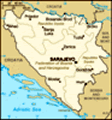Advertisement
Published: March 4th 2009
My last night in Serbia was dominated by apprehension, since I had read only on my last day in this schizophrenic country that all foreigners have to register with the local police within 24 hours of arrival. I decided to go to the immigration office and ask some vague questions. The man in charge was more than unfriendly, being very impatient and highly irritable having to deal with me and my questions. He said I would have to pay a hefty fine, but he didn't know exactly how much. In reply to my asking what would happen if I didn't pay and tried to leave the country, he said coldly: "Then you have problem at the border".
In reality it wasn't all too bad. I slept for the best part of the bus journey and only woke up when the border officials had already got on the bus. They took my passport, and I got it back five minutes later with the exit stamp in it. Having left Serbia and with an apparently big problem out of the way, I could feel my spirits rise to unprecedented heights. Add to this a stunning scenery, dramatic valleys flanked by steep hills
covered in snow, on the way to Sarajevo, and you got a really good bus trip.
The Bosnian capital still bears traces of the war and the lethal Siege of Sarajevo, which lasted for almost four years, from 1992-96. During the siege, more than 10,000 people were killed and over 50,000 wounded, 85% of which were civilians. Great damage was done by Serbian snipers who controlled military positions and randomly fired at every living being in sight. Most streets were so dangerous to cross that they became known as 'sniper alleys'. The Sarajevo Tunnel, which is part of the Tunnel Museum today, allowed supplies to come into the city, and people to get out.
Strangely enough, the UN never interfered with force to stop the killing, unlike in 1999, when Belgrade and other strategic targets in Serbia were bombed in response to Serbian massacres in Kosovo. Thus it also came to the infamous Srebrenica Massacre in July of 1995, when more than 8,000 Bosniak muslims were slaughtered by Bosnian Serbs under the command of Ratko Mladić, who happens to be still on the loose, probably being hidden somewhere in Serbia by sympathetic militaries and civilian Nationalists. Srebrenica had been
declared a UN-protected 'Safe Area', which didn't prevent the massacre, neither did the 400 Dutch peacekeepers.
Apart from the troubled history, Sarajevo remains one of the most enchanting European capitals, especially because of the Turkish influence, the kafana (traditonal coffee shop) culture, and the mixture of Oriental and Austro-Hungarian architecture. I roamed around the Turkish quarter, saw mosques, Catholic and Orthodox churches, an old synagogue that has been transformed into a Jewish museum, walked along the Miljacka river and across the manifold bridges, most notably the Latin Bridge, where on the 28th of June 1914 Franz Ferdinand, Archduke and heir to the throne of the Austro-Hungarian Empire, was on his last ride along with his wife Sophie, getting fatally shot just after crossing the bridge by the Bosnian Serb Gavrilo Princip. This, of course, led Austria-Hungary to declare war on Serbia, and to a chain of events that would start World War I.
An unpleasant experience was having to sleep in a dorm, where a French dreadlocked hippie scumbag, with flags of countries he visited stitched on his backpack, kept me awake by snoring like a dying goat. As he didn't react to my polite requesting, and subsequent
shouting that he stop it, I got up and slammed the door a couple of times, no, not with his head wedged between door and door frame, although that would have been a just retribution, after which he stopped it indeed. Ah yes, the joys of sleeping in crappy dorms with crappy people...
Another thing that I could have avoided was trying to defy logic, in that I didn't buy a ticket for the tram ride to the bus station, and getting inevitably caught in the process. My two words of Bosnian and the controller's two words of English didn't build a stable bridge over the language trench, and in the end I decided to pay the 27KM rather than missing my bus due to a longer dispute with those uneducated brutes.
The rest of my stay in Bosnia and Hercegovina was rather brief. One day in Jajce in the North of Bosnia, close to Republica Srpska, a sleepy little town that boasts little less than a waterfall and a fortress, and one day in Mostar, of destroyed-reconstructed-then-UNESCO-listing fame. I really felt I should stop lingering, since I'd already lost too much time in Zagreb and, very unnecessarily,
in Belgrade. So onwards it was to the Dalmatian coast, more precisely the wonderful city of Split, once again in Croatia.
But of that, children, I shall tell you the next time, and until then, don't you forget to brush the insides of your teeth, wipe your butt until the paper is clean, and don't be defiant to your parents, or the Almighty Bog, for that matter.
Advertisement
Tot: 0.048s; Tpl: 0.012s; cc: 8; qc: 24; dbt: 0.0254s; 1; m:domysql w:travelblog (10.17.0.13); sld: 1;
; mem: 1.1mb























